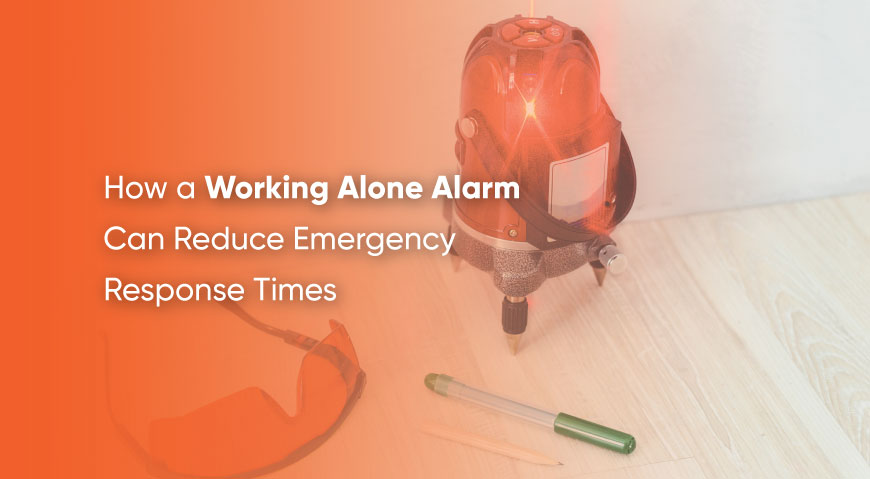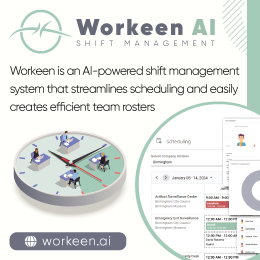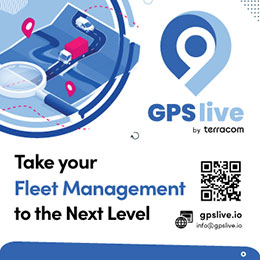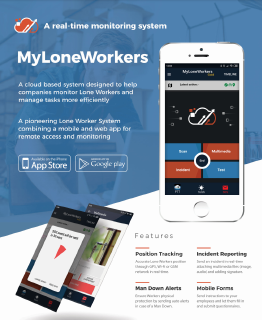
How a Working Alone Alarm Can Reduce Emergency Response Times
Table of Contents
- Understanding What a Working Alone Alarm Is
- The Hidden Dangers of Working Alone Without Alarms
- How Working Alone Alarms Solve Emergency Response Delays
- Real-World Scenarios: Working Alone Alarms in Action
- Benefits of Working Alone Alarms Beyond Faster Responses
- Why MyLoneWorkers Stands Out as a Working Alone Alarm Solution
- Conclusion: Embrace Working Alone Alarms for Safer Workplaces
Μany employees find themselves operating in isolation, whether patrolling remote sites, performing maintenance tasks, or handling field services. For these workers, a working alone alarm can be a lifesaver, providing immediate alerts that drastically cut down emergency response times. This technology ensures that help arrives swiftly when seconds matter most, turning potential disasters into manageable incidents.
As HSE managers, operations directors, and compliance officers, you're tasked with safeguarding your workforce. Implementing a reliable working alone alarm system not only addresses the inherent risks of working alone but also aligns with regulatory requirements. In this post, we'll explore how these alarms work, the problems they solve, and their real-world impact—all while highlighting innovative solutions like those from MyLoneWorkers.
Understanding What a Working Alone Alarm Is
A working alone alarm is a specialized safety device designed to protect employees who operate without direct supervision or nearby colleagues. These alarms integrate advanced technologies to detect and respond to emergencies automatically, ensuring that isolated workers receive prompt assistance.
At its core, a working alone alarm functions through features like BLE (Bluetooth Low Energy) panic buttons, man down alerts, GPS tracking, and welfare checks. For instance, a BLE panic button allows a worker to trigger an alert manually with a simple press, sending real-time notifications to a monitoring center. Man down alerts use sensors to detect falls or inactivity, automatically alerting supervisors if a worker collapses. GPS tracking provides precise location data, while welfare checks involve scheduled prompts to confirm a worker's safety—if missed, they trigger automatic alerts.
Systems like MyLoneWorkers exemplify this technology. As a cloud-based workforce management platform, MyLoneWorkers offers a suite of working alone alarm features, including man down detection via sensor clips on uniforms, external BLE panic buttons for hands-free SOS signals, and welfare checks that notify managers via web apps and email. These tools make working alone safer by bridging the gap between remote workers and their support teams.
By defining clear protocols, a working alone alarm empowers employees to focus on their tasks with confidence, knowing that help is just an alert away.
The Hidden Dangers of Working Alone Without Alarms
Working alone poses unique challenges, primarily due to delayed awareness of emergencies. When an employee is isolated—perhaps in a remote warehouse, on a construction site, or during night shifts—supervisors and colleagues may not realize something is wrong until hours later. This delay can escalate minor issues into life-threatening situations.
Consider the statistics: According to occupational safety reports, lone workers face higher risks of accidents, with response times often exceeding 30 minutes in unmonitored scenarios. Without a working alone alarm, factors like lack of communication, environmental hazards, or sudden health issues (e.g., heart attacks) can go unnoticed. The biggest risk? Time lost in detection, which directly impacts outcomes—delayed responses increase injury severity and recovery costs.
For HSE managers, this underscores the need for proactive measures. Working alone without safeguards not only endangers lives but also exposes employers to legal liabilities under regulations like OSHA or HSE guidelines. The problem isn't just isolation; it's the absence of instant visibility into a worker's status.
How Working Alone Alarms Solve Emergency Response Delays
The solution lies in the instantaneous nature of working alone alarms, which eliminate detection delays by providing real-time notifications. These systems connect workers directly to managers, control rooms, or emergency services, ensuring alerts are acted upon immediately.
Here's how it works: Upon activation—whether manual (via a panic button) or automatic (through man down sensors)—the alarm sends data including the worker's location via GPS, Wi-Fi, or GSM. This information reaches a central monitoring platform, allowing for rapid dispatch of help. For example, MyLoneWorkers uses cloud-based technology to process scans from NFC, Beacon, QR-code, or virtual checkpoints, instantly updating the web application with incident details.
Key mechanisms include:
- Instant Alerts: SOS buttons send notifications with timestamps and coordinates, even via SMS to multiple contacts.
- Automated Detection: Man down features detect falls using sensor clips, triggering alerts without worker input.
- Scheduled Checks: Welfare checks prompt responses at set intervals; missed ones alert managers automatically.
- Geofencing: Ensures workers stay within safe zones, notifying if boundaries are breached.
By integrating these, working alone alarms reduce response times from hours to minutes. Operations directors can monitor activities remotely, optimizing resource allocation while enhancing safety. This technology transforms working alone from a vulnerability into a controlled, secure practice.
Real-World Scenarios: Working Alone Alarms in Action
To illustrate the impact, let's examine hypothetical yet realistic scenarios where a working alone alarm makes a critical difference. Imagine a security guard patrolling a remote industrial site at night. He slips on uneven ground and falls unconscious. Without an alarm, colleagues might not discover him until the next shift—potentially hours later, leading to worsened injuries from exposure or bleeding. With a working alone alarm like MyLoneWorkers' man down detection, the sensor clip on his uniform detects the fall and sends an automatic alert to the monitoring center. GPS data pinpoints his location, and emergency services arrive within 10 minutes, preventing a tragedy.
Another example: A maintenance worker in a high-risk environment, such as an oil rig, suffers a sudden injury from equipment malfunction. Isolated and unable to reach his phone, he presses an external BLE panic button attached to his gear. The system, similar to MyLoneWorkers' BLE SOS functionality, notifies the control room instantly with photos or notes if attached via the app. Response time? Reduced from 45 minutes (manual check-ins) to under 5 minutes, allowing for quick medical intervention.
In a field service context, a technician working alone misses a welfare check due to a heatstroke episode. The automated system alerts managers via email and app, dispatching a team based on geofence data. These scenarios highlight how working alone alarms save time in detection and response, turning near-misses into safe resolutions.
Actionable Tip: Conduct risk assessments for lone roles and simulate emergencies to test your working alone alarm system's efficacy.
Benefits of Working Alone Alarms Beyond Faster Responses
While reducing response times is paramount, working alone alarms offer multifaceted benefits that extend to compliance, morale, and business efficiency.
First, enhanced regulatory compliance: By providing documented alerts and monitoring, these systems help meet standards like lone worker protection laws, reducing fines and audits. Employers minimize liability through proactive safety records.
Second, boosted worker confidence: Knowing a working alone alarm is in place, employees feel empowered. Features like MyLoneWorkers' SafePass for VIP clients or trail tracking for route visualization reassure workers that their well-being is prioritized.
Third, operational advantages:
- Cost Savings: Faster responses lower medical and downtime expenses.
- Productivity Gains: Real-time monitoring streamlines scheduling and resource use.
- Asset Protection: Geofence alerts safeguard equipment in remote areas.
For compliance officers, these benefits translate to a safer, more accountable workforce. Subtly, platforms like MyLoneWorkers integrate these perks seamlessly—no installation costs, quick setup, and cloud-based access make it an ideal choice for modern operations.
Why MyLoneWorkers Stands Out as a Working Alone Alarm Solution
When selecting a working alone alarm system, reliability and innovation matter. MyLoneWorkers is a comprehensive cloud-based platform tailored for field operations, offering robust features that directly enhance response times for working alone scenarios.
Key highlights include:
- Man Down Alerts: Sensor-based detection for falls, ensuring alerts even if the worker can't act.
- BLE Panic Buttons: External devices for instant SOS without needing a smartphone.
- Welfare Checks: Timed safety verifications with automatic notifications.
- Geofence and Tracking: Real-time location monitoring with path animations for quick response planning.
Why choose MyLoneWorkers? It requires no hefty installations, provides instant SOS alerts, and supports global management via secure cloud servers. Workers can attach multimedia to reports, enriching incident data for faster resolutions. This system not only protects lone workers but also optimizes daily tasks, making it a persuasive option for HSE professionals seeking efficiency and safety in one package.
Conclusion: Embrace Working Alone Alarms for Safer Workplaces
In summary, a working alone alarm is essential for mitigating the risks of working alone, directly slashing emergency response times through instant alerts and advanced detection. From defining the technology to exploring scenarios and benefits, it's clear that these systems can prevent serious incidents while fostering compliance and confidence.
For operations directors and HSE managers, investing in a solution like MyLoneWorkers—with its real-time monitoring, man down detection, welfare checks, and BLE panic buttons—ensures your team is protected. Don't wait for an emergency to highlight delays; implement a working alone alarm today and safeguard your workforce tomorrow.
Book a demo with us today or contact our team to learn more and start building a safer future.









